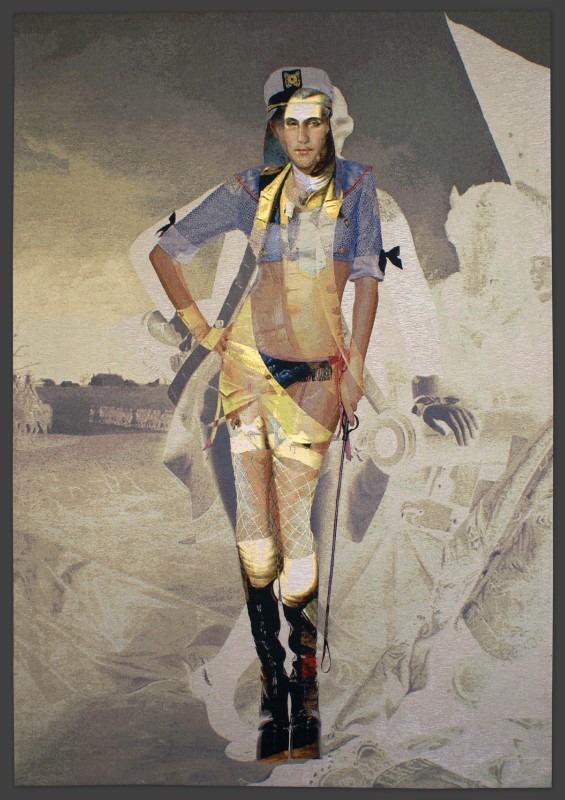
Jacquard tapestry
111 x 75 in.
edition of 6
Acclaimed as one of the San Francisco Bay Area’s premier painters, Deborah Oropallo has created much of her work in recent years using digital photos and inkjet prints. George, her 2007 tapestry with the Magnolia Tapestry Project, finds the artist broadening her exploration of digital media. In George, Oropallo juxtaposes different modes of portraiture, colliding two sets of signs into an image both alien and familiar. George is based on a digital collage that is part of a recent group of hybrid figures entitled Guise. The series combines opulent 18th century portraits of men with contemporary images of women whose revealing, cartoonlike uniforms evoke visual archetypes: a pirate, an S&M dominatrix, Santa Claus and the like. The women’s uniforms are campy, sexualized signs drawn from the world of advertising: a series of roles reduced to a collection of simple visual cues. By digitally merging them with the 18th century portraits, Oropallo scrambles the viewer’s radar. The costumes and details which lend the portraits their extravagance and pomp mingle with the womens’ stylized and suggestive uniforms in a virtual alphabetsoup of signs. In George, Washington’s portrait evokes power via a familiar iconography: the cannon, horse and flag; his military jacket and boots; even by his confident stance, with one hand on a jutting hip. Bizarrely, the female form possesses a virtually identical catalog of elements: the riding crop, boots, and military trimmings of her outfit and her cocky stance are drawn from the same matrix of visual indicators. Oropallo’s fragmented hybrid of the two figures invites a consideration of the different kinds of power they suggest, their levels of gravitas and dignity relative to each other, and the extent to which context and gender might inform our readings of the two. An additional layer of meaning is suggested by the artist’s use of the Magnolia Tapestry Project’s innovative weaving technique, whereby an image is generated by adjacent combinations of colored threads. As in pointillism, the image appears as a random collection of discrete colors at close range; only at a distance does the viewer apprehend familiar forms, as his or her eyes blend the colors together into a recognizable set of signs. Accordingly, even at its surface, George emphasizes the internal process by which the mind forges meaning from abstract visual material.
– Text by Nick Stone
show prices
Prices and availability are subject to change without notice.The copyright of all art images belongs to the individual artists and Magnolia Editions, Inc.
©2003-2025 Magnolia Editions, Inc. All rights reserved. contact us
